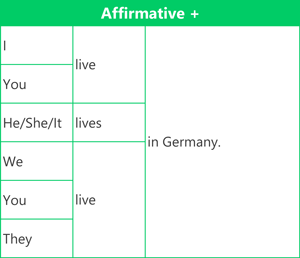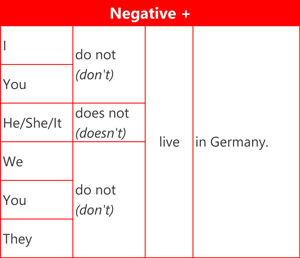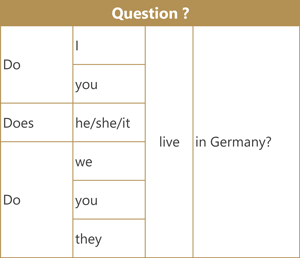What is the present simple?
The present simple (or simple present) is one of the English verb tenses.
You can learn more English online by visiting our free English grammar lessons, which include other verb tenses and more grammar points.
You can also find more grammar, vocabulary and communication tasks for each English level:
Use & examples |
We use the present simple tense to describe:

(1) Facts
[English level A1 - English level A2]
This describes general facts & permanent situations.
- I live in London.

(2) Habits
[English level A1 - English level A2]
This is something that you do regularly.
- I read the news every morning.

(3) States
[English level A1 - English level A2]
This is something that is not an action (e.g. emotions, thoughts, relationships, senses).
- I feel tired after work.

(4) Instructions
This includes giving instructions and directions.
- You take the first left.

(5) Fixed arrangements
This include schedules and timetables in the future.
- I leave for a meeting in New York at 4:00 p.m. tomorrow.
Form |
How do you write and pronounce the present simple?
Form: Key points
- Use the base form of the verb, which is the infinitive without 'to'.
- After 'he/she/it' in the positive form, the verb ends in 's'.
Here are examples of the affirmative (positive) form, negative form and question form using the verb 'live'.


Contractions
do not = don't / does not = doesn't

Short answers
Yes, I do. / No, I don't.
Pronunciation
The present simple with 's' (after he/she/it in the positive form) has three different pronunciation sounds.
- /s/ (e.g. works, eats) - when 's' comes after an unvoiced or silent sound.
- /z/ (e.g. lives, plays) - when 's' comes after a voiced consonant or vowel sound.
- /ɪz/ (e.g. watches, fixes) - when 's' comes after consonants with a hissing sound /ʧ/, /ʤ/, /ʃ/, /ʒ/, /z/, /s/.
Notes |
Spelling exceptions for verbs
For the present perfect simple, we have extra information about the exceptions:
1) Be
I am, You are, He/She/It is, We are, You are, They are.
Examples:
I am British.
You are German.
He is French.
2) Have, Go and Do after he/she/it (third person singular)
Change 'have' to 'has', 'go' to 'goes', and 'do' to 'does'.
Examples:
[have] He has a car.
[go] She goes to work at 8:30.
[do] He does her homework in the evening.
3) Verbs ending in 'consonant + y'
Change 'y' to 'ies'.
Examples:
[fly] She flies to Spain every year.
[cry] She cries during the film.
Compare verbs ending in 'vowel + y':
[play] He plays football.
4) Verbs ending in 's', 'z', 'ch', 'sh', 'x'
Add 'es' to base form.
Examples:
[watch] He watches television.
[fix] She fixes the car.
Quizzes |
Quiz 1: General facts, habits and states.
My friend and his job.
[Topic: Friends / Jobs]
Choose the correct forms of the present simple tense, the affirmative, negative or question form.